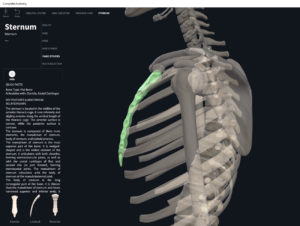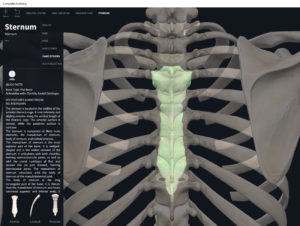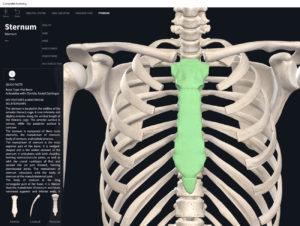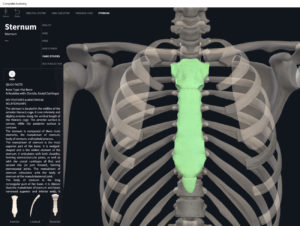Anatomy & Physiology: Bones—Sternum.
Structure.
- The sternum is comprised of 3 parts (descending order): manubrium, body, xiphoid process.
- Manubrium: most superior of the 3 parts; flat; name means “handle-like” or the vernacular “breastbone”; the suprasternal notch is distinguishable upon inspection and easily palpateable. The manubrium articulates with the medial ends of the clavicles on either side at the clavicular notch.
- Body: largest piece of the sternum; flattish and elongated. Articulates with the manubrium at the sternal angle. Articulates with the costal cartilages of ribs 2-10.
- Xiphoid process: the most inferior and smallest portion of the sternum. It is triangle-shaped. It’s made of hyaline and doesn’t ossify until about 40 yrs old. The xiphoid is an attachment site for some abdominal muscles. The xiphoid is palpateable and it has a “give”; it can also be painful to even slightly depress that area.
Function.
Clinical Significance.
- Sternal angle: clinical landmark for locating rib #2 and counting ribs as reference points to internal organs like the heart.
- Xiphoid process: incorrect alignment for CPR may cause the xiphoid to fracture off and drive it into (and damage) the internal organs.
References
Biel, A. (2015). Trail guide to the body: A hands-on guide to locating muscles, bones and more.
Cedars-Sinai. (2018). Vertebrae of the spine. Retrieved from https://www.cedars-sinai.org/health-library/diseases-and-conditions/v/vertebrae-of-the-spine.html
Jenkins, G., & Tortora, G. J. (2012). Anatomy and Physiology: From Science to Life, 3rd Edition International Stu. John Wiley & Sons.
Muscolino, J. E. (2017). The muscular system manual: The skeletal muscles of the human body.




